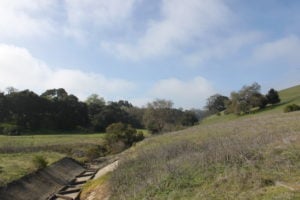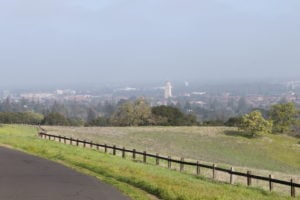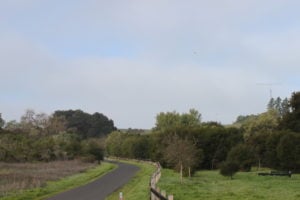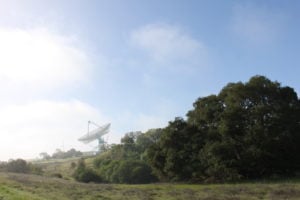After the one-mile bike ride in dark jeans, a heavy sweater and riding boots, I was already soaked in sweat. When my friends advised me to wear athletic clothing and sneakers, I ignored their advice because I had little time to accomplish this rite of passage for all Stanford students, one I should’ve done as a freshman. “You can’t just walk The Dish,” they said. “You have to hike it.” Their nonchalant statement echoed in my mind like a mild warning. I was about to endeavor on a personal journey that I hoped would bring the same zen I felt while watching Netflix after turning in a large assignment.

Parking my bike alongside only a handful of others, I gazed at the steep hill in front of me with awe. Even at the bottom, the sadness and anxiety that came with losing an important person in my life less than 24 hours before disappeared. I walked full-speed ahead, not paying attention to the runners who passed me like sports cars on a highway. Under the blazing Californian sun, the moderate 60-degree forecast had me fanning my face as I hiked up what seemed like a mountain. The trek had taken me less than 10 minutes, but I stayed at the top for almost an hour. The scenery was postcard-worthy: The San Francisco Bay reflected the solar rays in a way that it resembled a sea of blue tinsel, the thick foliage hid building tops like a jungle canopy and the shadowlike mountains faded into the background of the horizon.
But what gave me this view was the hill I stood on, a hill with dry grasses and looming trees and unafraid wildlife. A hill whose initial challenge gives way to a treasure trove of nature. A hill that can’t be found on any other college campus in the country. And so began a series of thoughts that would drive my curiosity over the next few days. With Stanford considered one of the most beautiful, eco-friendly campuses, how do more urban schools compare? How do students feel about the overabundance of cement and asphalt? Are there enough green spaces and parks to accommodate for the lack of natural vegetation? Has Stanford spoiled its students and faculty with well-manicured landscaping and conserved ecosystems? Do enough students take advantage of these beautiful landscapes? I took to asking a few of my high school friends who currently attend urban schools to find out.

Eric Miller, a sophomore at Case Western Reserve University in Cleveland, describes his campus as one where students have to go out of their way to connect with nature. “There are only about 3-4 places for students to play [sports]. A few times, I [have gone] to a park near Lake Erie; however, I either need a friend to drive me there or bike about 25-30 minutes,” he said. “I also have heard of students going to a local park, but I believe it is about a 45-minute trip. The closest thing [that resembles a park] is a cemetery.”
New York University sophomore Darshana Paramesh considers nearby Washington Square Park to be part of her urban campus, even if there’s relatively little vegetation. “Washington Square Park is probably the main park that most NYU students take advantage of because it’s literally across the street from the dining halls and academic buildings,” she stated. “Most people chill on the benches or sit in the fountain with their friends or by themselves just relaxing or eating food.”
While both Miller and Paramesh find their universities to have limited access to green spaces, sophomore Anupama Shah loves the lush lawns of Georgia Tech University in Atlanta. “Even though our campus is technically an open campus, it really feels like its own place,” she said. “And while you can see the skyscrapers from campus, there’s a lot of green space that makes it nice to study, exercise or just relax.”
As I sat reading their extensive answers on Facebook Messenger, it occurred to me that all three of my friends spoke positively about the effects of nature on students in general. They emphasized how much stress relief a simple walk through a wooded park or laying out in the sun on a grassy field could provide. Although they might need to travel to find these calming environments, all three appreciate what’s offered within the borders of their campuses. They take advantage of the small spaces and sparse trees, even if they’re not necessarily “nature people.”

I wouldn’t consider myself a “nature person” either. Besides being allergic to most trees and grasses, I don’t think I could differentiate a California sycamore from a Quaking aspen. I can’t tell whether a plant is drought or flood or fire-resistant. And sometimes when I’m really tired returning to my dorm in the dark, racoons and jackrabbits look very similar to me. While I find nature incredibly beautiful, I think my ambivalence toward its other ecosystem services has made me blind toward Stanford’s impressive horticultural and conservation efforts.
Mike Burnett ’18, an earth systems student advisor, assured me that I’m not alone.
“I think a lot of people may never realize how important it is for a campus to incorporate natural spaces into its design,” he said. “So many people go years here without stopping to notice the beautiful trees or the lively birds, and I don’t know if they’d notice their absence any more than their presence, but I’d wager there’s some subconscious component to it.”
On the mile-long ride back from The Dish, I felt refreshed, relaxed and unconcerned with the eight-page essay due that night. I slowed down on the footpath that runs parallel to Stanford Avenue. Partially masked from the busy road, the paved trail serpentines around wide trees and overgrown hedges, but that’s what I found enchanting about it. I thought about Palm Drive, the Oval, the Arizona Cactus Garden, Lake Lagunita, Wilbur Field, the Arboretum, Meyer Green and other places less known. I’d grown to love each of these places over my short career as a Stanford student, but for what reason? For their iconic status? For their beauty?
For whatever reason I’d subconsciously learned to adore these places of manicured beauty, I hadn’t thought about the effort that goes into planning, maintaining and conserving the landscape of the largest campus by acreage in the country. I wondered if anyone had, really.

Cathy Blake, the University Landscape Architect and Director of Campus Planning, revealed just some of the considerations that go into planning a new landscape: “What is the status of all existing trees and can they be preserved or moved? How will the space be most useable by students, faculty and staff? How can the landscape both visually and functionally support the architecture? Where will bike parking go and how much and how is it defined to not unsafely interfere with pedestrian and disability access? Is the plant palette consistent with Stanford’s water use policies, natural type plantings, food production or other goals?”
The number of factors that go into constructing a new place for people to enjoy was much more than I ever expected. The workers dedicated to ensuring actions like mature tree transplantation and seedling reforestation have been successful. They care about tending to the native or drought-resistant plants that make up about 75 percent of all vegetation on campus. It’s also important to know that any reusable waste from trees or shrub clippings is composted or cut into wood chips for all-campus use.
Alan Launer ’82 M.S. ’82, the Associate Director of Conservation Planning, believes strongly that Stanford’s efforts to keep conservation and landscaping closely linked are admirable.
“Stanford does vastly more conservation than is required and does much more than virtually every other entity which [is] not specifically oriented for biological conservation,” he said. “[The university’s] efforts can be grouped into set[ting] aside biologically sensitive lands, managing lands for conservation, working with local jurisdictions, creative environmental ‘enhancements’, funding the conservation program and educating [its faculty and students].”
And when I slowed down to park my bike in front of my dorm, I looked around at the nameless trees and the bushes covered in mystery berries and the unknown birds pecking at the ground. It didn’t matter that I was sweaty or overloaded with work or saddened by the loss of my family member. All I felt was calm. Calm in knowing that I can learn the names of trees or berries and birds. Calm in knowing that I can hike The Dish again in more appropriate clothing. Calm in knowing that I can always rely on Stanford’s natural beauty to bring me happiness.
Contact Emily Schmidt at egs1997 ‘at’ stanford.edu.